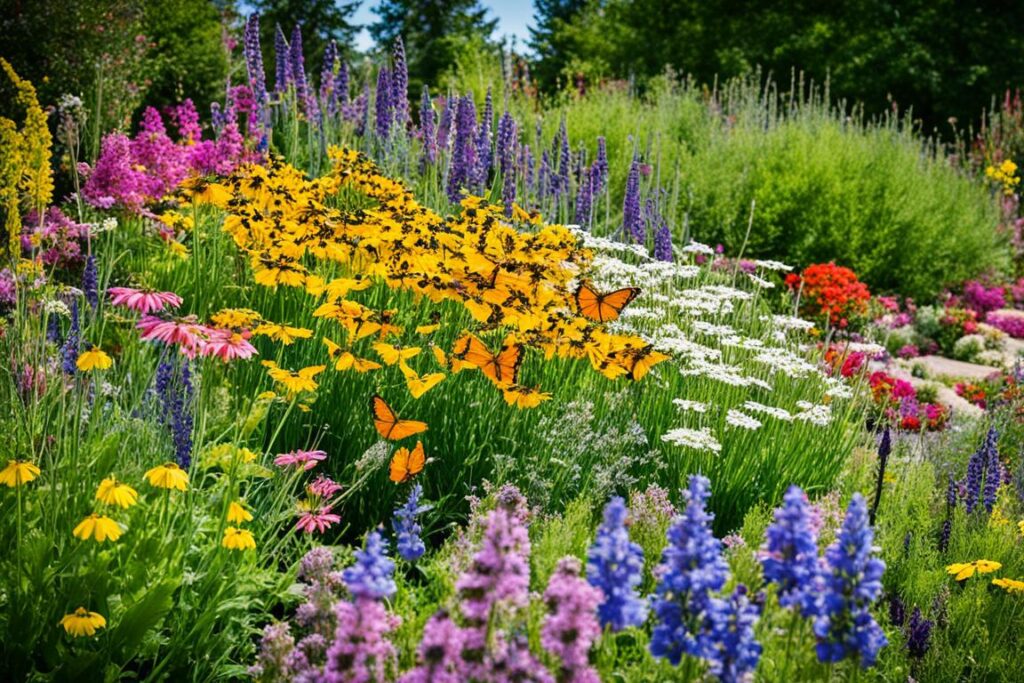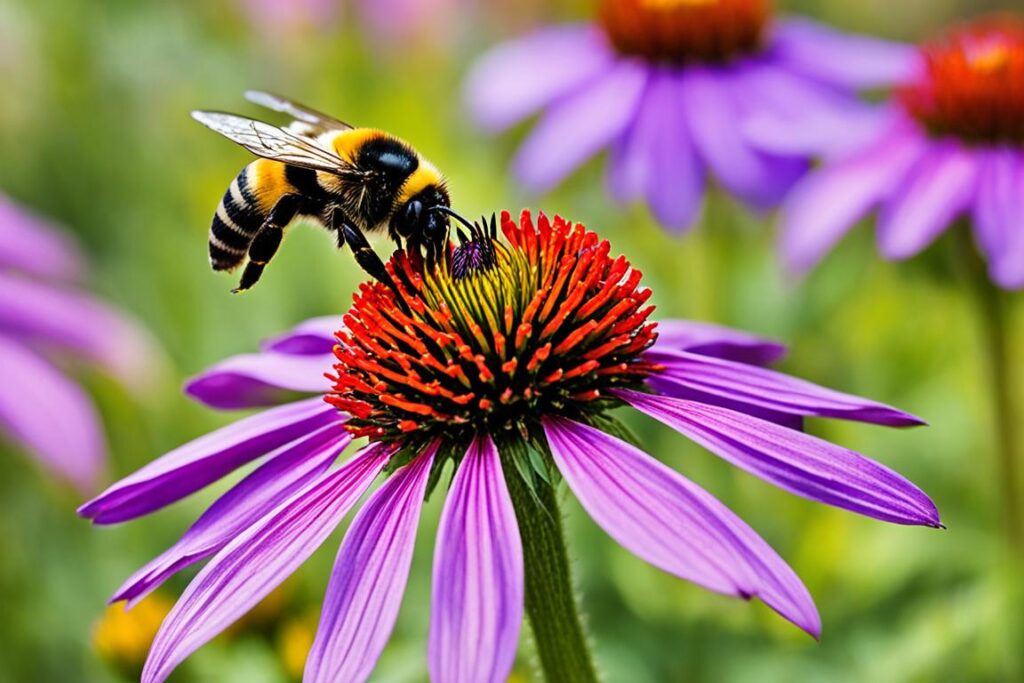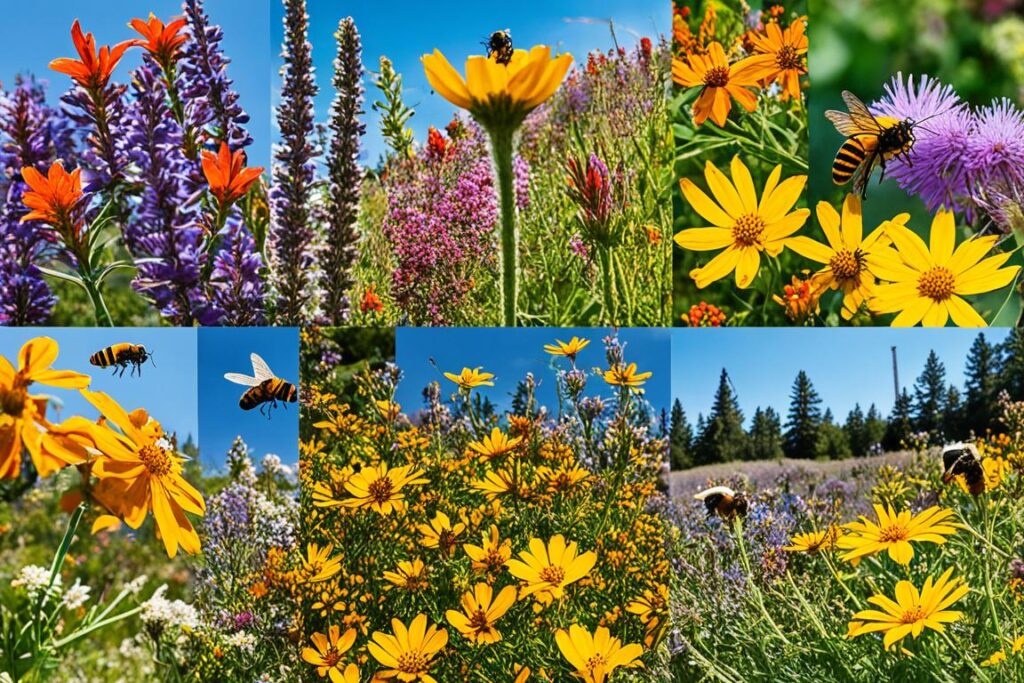To attract bees, butterflies, and other pollinators, it’s key to pick the right Pollinator-Friendly Flowers. Native flowers are great because they’ve evolved with local pollinators. They offer a known food source. Think about where you want your garden and the kind of soil and sunlight it gets. Look up which native plants do well in your area. Pick ones that flower at different times during the year. You can grow these from seed or from small plants, depending on your time and money. When you start planting, get the soil ready, plant the seeds or little flowers right, and keep up with watering and weeding.
Key Takeaways:
- Choose pollinator-friendly flowers to attract bees, butterflies, and other pollinators.
- Native flowers provide a familiar food source for local pollinators.
- Plan your garden location based on soil type and sunlight conditions.
- Select native plants suited for your area and ensure they bloom at different times throughout the growing season.
- Prepare the soil, plant the seeds or flowers properly, and provide regular maintenance for a thriving pollinator-friendly garden.
Essential Tips for Creating a Pollinator-Friendly Garden
Creating a garden that welcomes pollinators like bees is important. There are key tips to help attract various pollinators. By following these, you can promote a healthier garden and help local wildlife thrive.
1. Embrace Garden Biodiversity
It’s vital to have many types of plants in your garden. Choose various flowers that are rich in nectar and pollen, in different looks. Avoid plants that don’t provide food for pollinators. This way, you ensure there’s always something blooming for them.
2. Plant Native Species
Focus on using plants that are native to your region. These plants are best for local pollinators. They’re used to these plants and they help support the ecosystem. Make sure to buy from trusted sources to get true native plants.
3. Consider Bloom Times
Plan your garden so it blooms from early spring to late fall. This is important to feed pollinators all season. Mix in flowers that bloom at different times. This keeps a wide range of pollinators happy.
4. Create Drifts and Avoid Landscape Fabric
Plant in groups or drifts to make your garden more pollinator-friendly. This provides more nectar and pollen in one spot, attracting them. Also, stay away from landscape fabric or heavy mulch. They can block soil access for some pollinators.
5. Include Larval Host Plants
Host plants for butterfly and moth caterpillars are important. These plants are where these insects lay their eggs. Including them supports the entire life cycle of these pollinators.
6. Maintenance and Care
Looking after your garden is key. Make sure your plants get enough water and food. Remove weeds and look out for pests. This care keeps your garden healthy for the pollinators.
| Benefit | Tip |
|---|---|
| Increase Garden Biodiversity | Incorporate a wide variety of pollinator plants to attract different species and promote garden biodiversity. |
| Support Local Ecosystems | Choose native plants to provide familiar food sources for local pollinators and support local ecosystems. |
| Provide Continuous Nutrition | Plan your garden to have flowers in bloom from early spring to late fall to provide continuous nutrition for pollinators. |
| Create Attractive Habitat | Plant pollinator plants in drifts and avoid landscape fabric to create an attractive habitat for pollinators. |
| Support Life Cycle | Include larval host plants to support the life cycle of butterflies and moths. |
| Maintenance and Care | Provide regular maintenance, including watering, weeding, and pest management, to ensure the health of your pollinator-friendly garden. |
Using these tips will help you build a great garden for pollinators. Watching bees and butterflies in your garden is not only fun but also helps protect these essential creatures and their homes.

The Importance of Pollinator Gardens
Pollinator gardens are vital for our ecosystem health. They support a variety of bees, butterflies, and moths. These creatures help many plants, including our food, to grow by pollinating them.
Homeowners can help save these important pollinators. By making their gardens friendly to these insects, they contribute to their survival. These gardens also help diverse wildlife like birds and bats find homes.
Gardens with many flowers welcome more pollinators. This leads to better plant pollination and more food and seeds. It’s a cycle that benefits not just the garden but the whole natural world.
Adding native plants to your garden not only makes it pretty but also helps maintain a healthy balance. This plant diversity supports a variety of wildlife and assists in pest management. It’s good for the garden and the environment.
Having a pollinator garden makes your outdoor area look better and helps save necessary insects. By selecting different plants and making a comfortable place for them, you can help keep the environment thriving.

Benefits of Pollinator Gardens:
- Support healthy ecosystems and biodiversity
- Improve pollination and increase fruit and seed production
- Attract a variety of pollinators, including bees, butterflies, and moths
- Provide a habitat for other wildlife, such as reptiles, birds, bats, and beetles
- Help control pests and improve garden health
Putting in a pollinator garden is a great way to help the environment. It also makes your yard more pleasant and brings in pollinators. There are many benefits to having one.
Get seeds and plants for pollinators for your garden from Pollinator, Select Seeds
Conclusion
Creating a garden that welcomes pollinators with native flowers is a great idea. It helps local ecosystems and draws in many different pollinators. With the right location and plant choices, you can make a home for bees, butterflies, and more.
When designing your garden, focus on using native flowers. They work well with local pollinators and offer them familiar food. Mixing various native plants that bloom at different times and have different flowers ensures a steady supply of nectar and pollen.
This work goes beyond just a lovely garden. It supports garden biodiversity and protects wildlife. Watching pollinators enjoy your garden’s flowers lets you know you’re helping the environment. And you’re playing a part in keeping pollinator populations strong for tomorrow.



